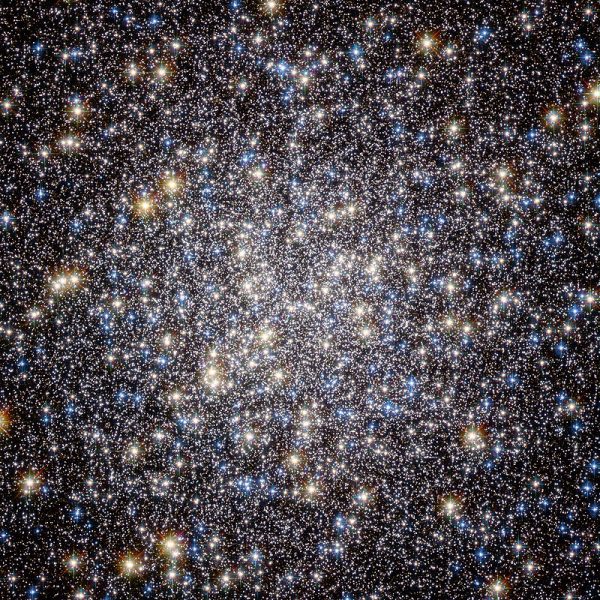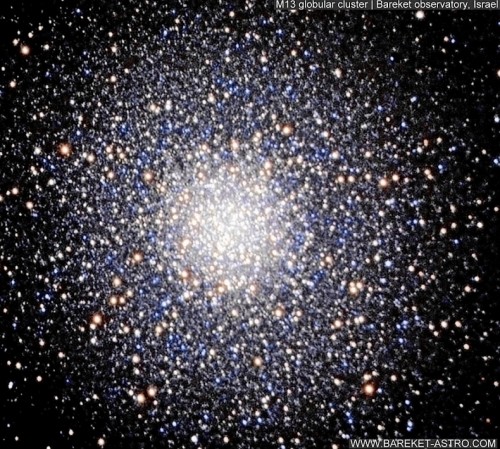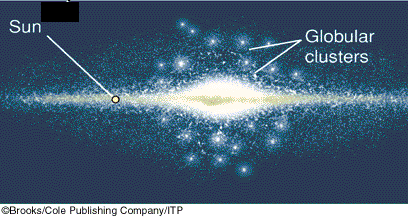![]()

View larger. | The heart of M13, aka the Great Cluster in Hercules, a globular star cluster and one of our Milky Way galaxy’s oldest inhabitants. This image was acquired by the Advanced Camera for Surveys on the Hubble Space Telescope.
The Great Cluster in the constellation Hercules – also known as Messier 13, or M13 – is considered to be the finest globular cluster in the northern half of the heavens. It’s found in a star pattern called the Keystone – a lopsided square within the constellation Hercules – between the two brightest stars of northern spring and summer, Vega and Arcturus.
At mid-northern latitudes, the M13 cluster can be found in the sky for at least part of the night all year round. It’s up part of the night in April, and all night long in May, June and July. In August and September the Hercules cluster is still very much a night owl, staying up till after midnight.
When you gaze at M13 or other globulars, you are looking at stars that are thought to be 12 to 13 billion years old. That’s almost as old as the universe.
M13 is not the easiest of sky objects to spot, but once you find it, you’ll be able to go back to it again and again. It’s located in the constellation Hercules, between summertime’s two brightest stars, Vega and Arcturus.

The bright stars Vega in the constellation Lyra and the orange star Arcturus in the constellation Bootes are located on either side of the constellation Hercules. Notice the squarish pattern within Hercules. This pattern is called the Keystone. M13 is located along one of the borders of the Keystone.
About one-third the way from Vega to Arcturus, locate the four modestly bright stars forming the Keystone of Hercules. On the Arcturus side of the Keystone, M13 is found between the stars Eta Herculis and Zeta Herculis.
A typical binocular field is about 5 to 6 degrees in diameter, and the Hercules cluster is found about 2.5 degrees south of Eta Herculis.

Sky chart of the constellation Hercules, showing the whereabouts of Messier 13 or the Hercules cluster. Click here for a larger chart.
On a dark, clear night, the unaided eye barely perceives the Hercules cluster as a faint and possibly fuzzy point of light. This fuzzy “star” is much easier to make out in binoculars.
And of course it’s not a star. It’s a globular star cluster, a huge globe-shaped stellar city teeming with hundreds of thousands of stars. Globular clusters orbit the Milky Way galaxy outside the galactic disk at tens of thousands of light-years away. In contrast, the relatively nearby Pleiades and Hyades open star clusters reside within the galactic disk, and usually harbor a few hundred to a thousand stars.
The best way to see M13 – or any globular cluster – is through telescopes with large apertures (light-gathering capability). Otherwise, the stars in this cluster at 25,000 light-years away are hard to resolve, that is, it’s hard to see them as anything but a fuzzy blur.
Even with a low-power telescope, this cluster looks hazy. It resembles a comet in appearance. In fact, the famous comet hunter Charles Messier (1730-1817) listed M13 in his Messier catalog, to steer comet seekers away from this masquerade comet.
If you don’t have a telescope, or are unfamiliar with how to use one, how about attending a public star party? That way you can view M13 through an assortment of telescopes.

M13, aka the Great Cluster in Hercules. Photo via Bareket Observatory in Israel, via CelestronImages.
Hercules cluster’s position is Right Ascension: 16h 41.7m; Declination: 36 degrees 28′ north
Bottom line: Many stargazers call it the finest globular cluster in the northern half of the heavens. It’s M13, also known as the Great Cluster in Hercules.
Source:
https://earthsky.org/clusters-nebulae-galaxies/m13-finest-globular-cluster-in-northern-skies
